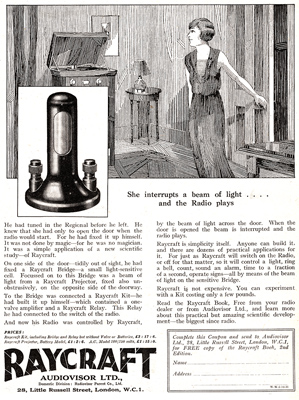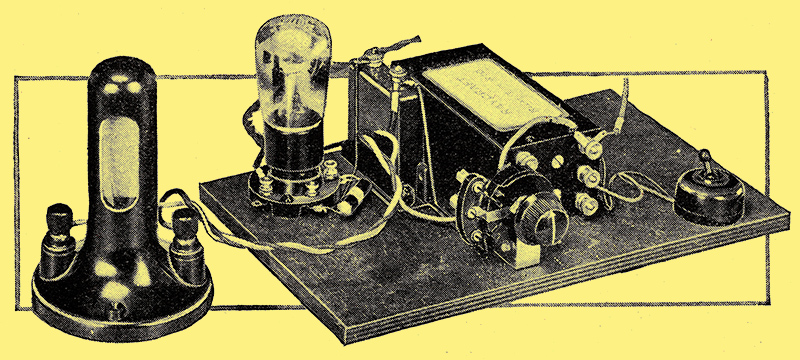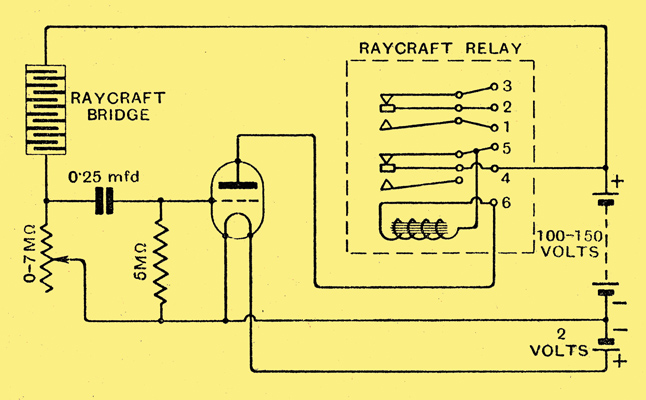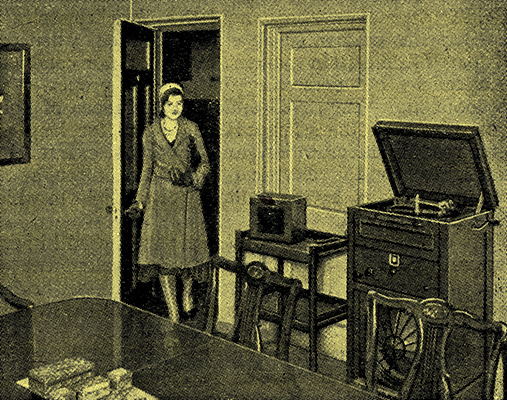|

The Raycraft Bridge advert.
Raycraft Constructor's Kit for Building a Relay Operated by an Invisible Ray
Just over a century ago the Swedish scientist Berzelius discovered an element, Which, when prepared in a certain manner, became a fair conductor of electricity but possessing the peculiar property that its conductivity improved under the influence of light. Thus was born the selenium cell, which for long has been used in laboratories, and to some extent elsewhere, to control electrical apparatus through the medium of relays, by the brilliancy of the light to which the cell is exposed.
The commercial types of selenium cells used hitherto were rather costly, but recently a new development has been made which, in the form of the Raycraft Bridge, brings this useful device within the reach of the average experimenter.

The complete set-up with applications to property protection.
It is a selenium cell of compact size and, withal, comparatively cheap, so that in the near future light control of electrical and other apparatus will undoubtedly play an important part in everyday life. The sensitivity of the bridge to artificial light is its greatest asset, for it can be used on numerous occasions indoors both for amusement and for serious purposes.
At this season we are particularly interested in devices which afford entertainment, and those which possess an element of mystery always have the great-est appeal. The Raycraft kit contains all the necessary components for the construction of a sensitive light-controlled bridge. It consists of two main parts, the Raycraft bridge and a single valve amplifier incorporating a special relay, by means of which the current changes in the sensitive cell are, after amplification, made to light lamps, ring bells, and switch on and off a wireless receiver, to mention a few of its many applications.
Small Current Consumption

The Raycraft kit assembled showing the special selenium cell on the left. Note the addition of a switch on the baseboard to short circuit terminals 4 and 5 when required.
The valve specified is a Mullard PM2DX, or one of similar characteristics, which can be operated at between 100 and 150 Volts HT The same battery supplies the selenium cell, and as a resistance of about seven megohms is connected in series with it, the drain on the battery from this source is negligible. The normal current taken by the valve is of the order of only four to five milliamperes.
The sensitivity of the apparatus can be enhanced by enclosing the bridge and its amplifier in a cabinet, thus shading the sensitive cell from as much stray light as possible, and employing a special projector lamp giving a strong concentrated beam. When used in the dark the presence of the apparatus will be undetectable if an invisible ray is employed; this can be arranged by fitting a light filter to the projector which kills the visible light, allowing the 'infra' red rays only to pass through. These will act on the selenium in the same way as visible rays.

Theoretical circuit diagram.
The theoretical arrangement is given in. the circuit diagram, which shows the relay contacts in the position taken up when the magnet is energised, by the anode current passed by the valve. To do this, terminals 4 and 5 are short-circuited. If the apparatus is required to set some external electrical devices, in, action, which continues to operate until switched off, then terminals 1 and 2 are used, and after setting the relay, the connecting strap between terminals 4 and 5 is removed. As this strap must be removed without disturbing the HT lead, it would be advisable to fit a small on-off switch to short-circuit these terminals when necessary. By connecting the external circuit to terminals 2 and 3, the lamp, bell, or radio-gramophone will cease to operate when the light beam is intercepted. Now, if terminals 4 and 5 are permanently connected and terminals I and 2 joined to the external circuit, the contacts will close when the light beam is interrupted as before, but they will remain closed for about four seconds only, and then they open automatically resetting the relay for the next interruption of the light beam. Some very amusing effects can be produced by this means, for example, by mounting the bridge and amplifier on one side of a door and the projector on the other side; each time the door is opened and the incoming person intercepts the light ray, a bell can be made to ring, a light go on or go out, or a wireless receiver brought in, or put out, of action. A variation of this would be to locate the apparatus so that by merely walking across the room similar effects are produced.
A Useful Burglar Alarm
Arrangements could be made so that anyone extending an arm to remove an article placed on ta table causes bells to ring, lamps to light or, by suitable wiring, for the light to change from white to red, or any other colour. There are endless possibilities in this direction, all of which possess that desired element of mystery so welcome at Christmas. For the benefit of the younger members of the household mechanical toys, such as model electric railways, can be stopped, or signals operated, when the train passes through the ray and, without human intervention, continue their course after a short interval.
There is at serious side to the usefulness of the Raycraft bridge, for it is far from being a toy. Its potentialities as a burglar alarm are enormous, especially as with a light filter fitted to the projector lamp the ray is invisible in the dark. To take another case; suitably arranged a hall light will come on when the front door is opened, thereby obviating the necessity for groping in the dark for the switch.
An Electrical Counting Device
It can be turned to good account in industry, as the bridge can be utilised to count articles carried along a conveyor by attaching an electrical counter to the relay terminals. If a four-second relay is too long for this purpose, the relay action can be speeded up by fitting a smaller grid capacitor or using a lower value grid leak.
Space forbids more than a brief reference to a few of the possible applications of the Raycraft kit, but enough has been said to show that it has endless possibilities even at this comparatively early stage in its history, when its potentialities have not, by any means, been fully explored.
The Raycraft kit is made by Audiovisor, Ltd., 28, Little Russell Street, London, WC., and the price, complete with wiring diagram and instructional booklet, which incidentally contains many suggestions for its application, costs £3 17s. 6d., without valve or batteries.
The special projector, lamp is available for battery use at £1. 2s. 6d., while an AC mains model costs £1. 15s. The lamp is made especially for this purpose by Joseph Lucas, Ltd., and is fitted with a 4 Volt bulb consuming two Watts, and a light filter to produce the invisible ray is included.

The possibilities of the Raycraft apparatus are innumerable. Here is shown a radio-gramophone switched on by the opening of a door which intercepts a light ray.
|